When I was reading over the article “Diurnal variation in stature: is stretching the answer?” which I cited as the main source in the recent post “How Much More Height Can Be Gain From Stretching For Morning, After Waking Up Height? (Important)” there was a small section that got me interested which is where an auxologist who was measuring children suggested that there might be a way for children at least to push themselves up (ie stretching) so that they get get to their maximum height.
In that article, the point the researchers were making was that for a physician or anyone measuring a child to get the real height measurement, the child should not be trying to force themselves to stretch out to the maximum since the real height is the mean aka average measured value.
The section I am talking about is below…
A stretching technique did become widely adopted about 20 years ago, however, after Whitehouse et alsuggested that ‘gentle upward pressure on the mastoid processes’ could minimise the eVects of diurnal variation.11 Indeed, these authors claim to have shown that, using this technique, loss in stature between morning and afternoon, though not entirely eliminated, can be reduced to a maximum of 0.46 cm.
This section in the article seems to suggest that we can stretch our body out to upwards of even more than 0.25 inches just from a simple act of pushing at a part of our skull bone. The area of the skull is something known as the Mastoid Process. I wanted to see just where this mastoid process is so I googled it and the Wikipedia article on this bump in the skull was the first thing that popped up.
 The Mastoid Process is talked about in Wikipedia If we use our hands and fingers to feel it out, it would be located about 1 cm behind where our lower earlobe would be, called the lobule.
The Mastoid Process is talked about in Wikipedia If we use our hands and fingers to feel it out, it would be located about 1 cm behind where our lower earlobe would be, called the lobule.
Refer to the picture to the right, where the highlight square is focusing on.
So the method is to give a firm, constant, upward pressure on the mastoid process to increase our measured height.
The article had said that this method wouldn’t work, but I might have to disagree due to what I have seen from my own experiences.
Theory
If we view the skull as an irregular bone that is attached to the upper most cervical vertebrate bone by a diarthrosis/synovial joint which can only move in 1 main direction (I am purposely neglecting the fact that the head can swivel side to side for this example to simplify the diagram so I can make a point), from up to down, then we can say that the head is like the femur where there is an imaginary axis line that passes through the lateral sides of the head where the center of the head turning would be. Note: I am currently using Anatomical terms of location for convenience and standardization purposes. If we are pushing on the mastoid process, we are effectively turning the head downwards, towards the rostral-ventral direction, but just a little.
This means that what Whitehead is really doing when he tells auxologists who do the measurements and apply upward pressure to the children’s head is to turn the head downward ventrally, while at the same time pulling at the dorsal side of the need up.
This idea was something that I had proposed many months ago in a post. I noticed this phenomena where my measured height would increase by around 1/4th of an inch almost by turing the head down and puffing up the back neck area, from watching how my height would change when I turned my head which was shave at that time (years ago).
I talked about this idea in a very old post “Grow Taller By Head Tilting”
Example
I would like to refer to the side view profile of the NBA player Kobe Bryant to see a good example of what I am talking about.
Most groups and tribes of people have hair that is not shaved short enough to be able to remove the measure error attributed to hair, but for the African American community, the males there prefer the really close shave for a hair fashion style which works foe them.
Let’s look at Kobe Bryants head shape. From the side view, we can see that his head is not a completely round circle from the side. There are certain part of his skull which bulge out slightly. That area is the back skull area, which is more pronounced. Kobe has a thin nose, high cheek bones, and angular features for his eyes. His face is teardrop shaped, and his forehead is not pronounced. I would say that he is a handsome man. It is the back, upper area of his head that I wanted to focus on.
If Kobe was to have his height measured at the position you see him in that wallpaper, then he would not be as tall than if he turned his head downwards and pushed the pack of his skull using the back neck muscles. The different for Kobe can be as much as 1.5 cms, but it would be noticeable since the head is shaved.
For most people, their forehead like Kobe’s (who just happend to have it more visible due to his shaved head) is not as pronounced as the back of their head. If you are trying to make sure you get the highest measured value for height, the pushing of the mastoid process might work, but only if you make sure the result is to turn the head downward and lift the bigger, thicker back of the head up for measurement.
Note: This post is a little more controversial than some posts due to the fact that I am doing a very systematic analysis on the skull features of a rather famous, well known athlete. I have nothing against the guy but using a picture I found from Google Images.

